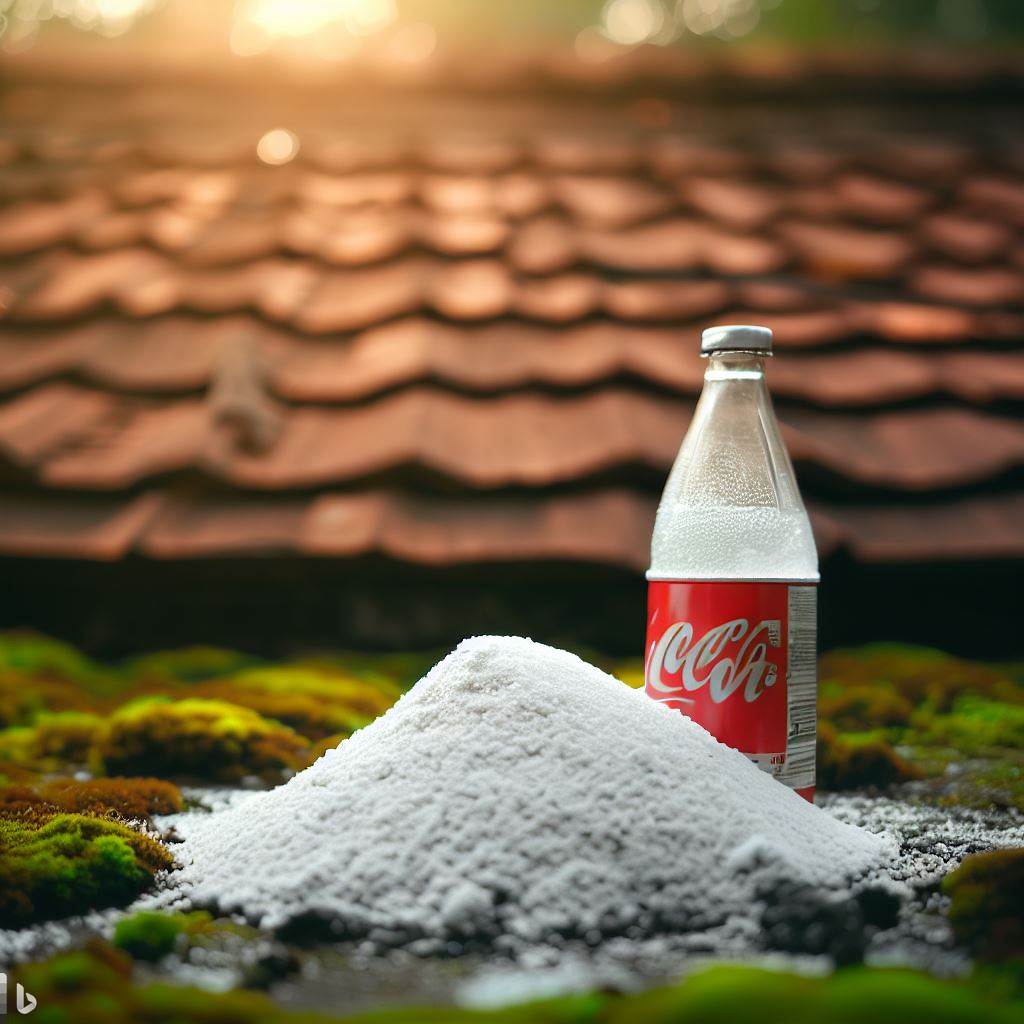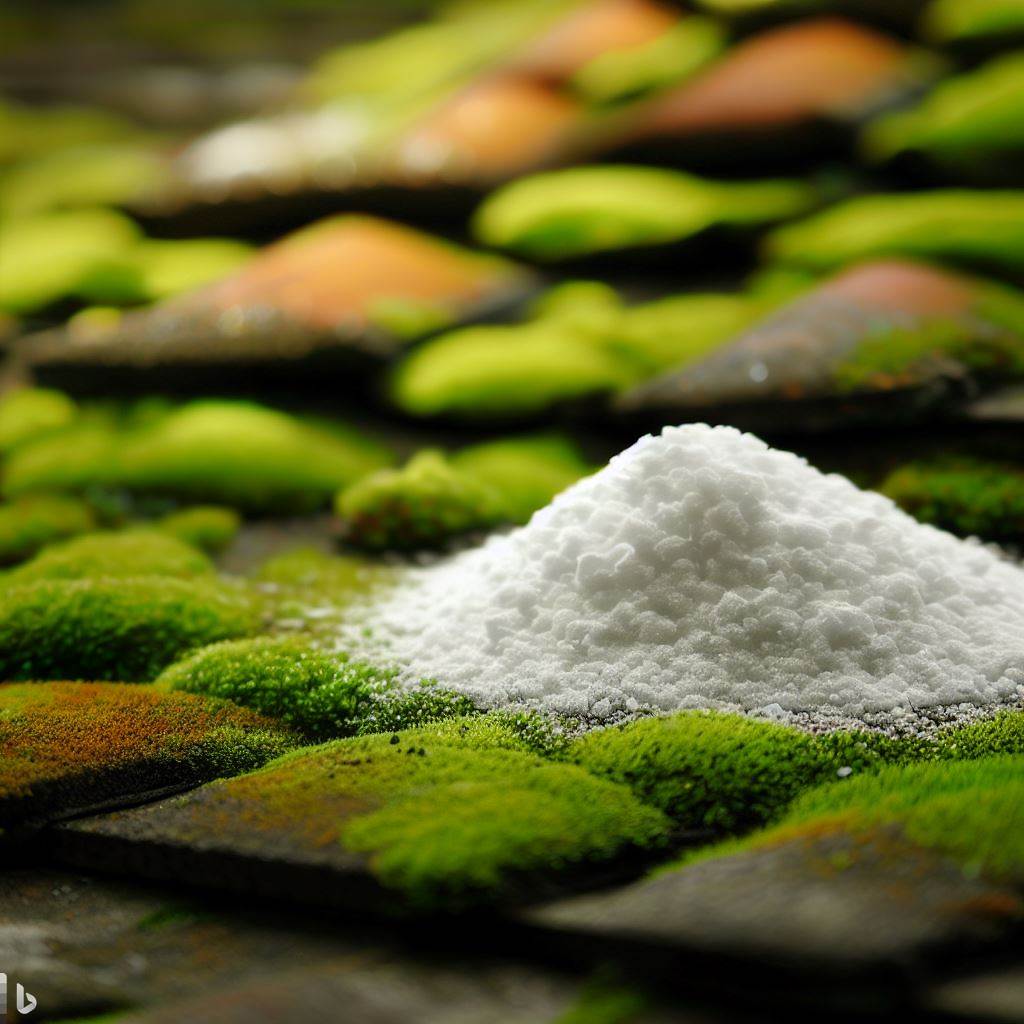Sure, it may look quaint nestled among the shingles, bringing a touch of the deep forest to your suburban abode. But don’t let that serene facade fool you! This green menace – Moss – latches onto roofs tighter than an octopus in zero gravity and is as stubborn as they come.
What’s your secret weapon against this trespasser? Baking soda – yes, you read right! That humble box sitting in your pantry isn’t just for chocolate chip cookies anymore. Its potential to combat roof moss might surprise you more than an unexpected plot twist in your favorite thriller.
Discover intriguing insights and step-by-step instructions for utilizing the power of baking soda roof moss eviction.
Get ready for an exciting journey as we explore the fizz and suspense in banishing unwanted roof moss.
Uncover the magic of a moss-free rooftop!

Identifying the Problem of Moss Growth on Roofs
Roof moss is a common issue that many homeowners face. The lush green growth may seem harmless, but it can wreak havoc on your roof. Moss tends to thrive in damp and shaded areas, making roofs an ideal breeding ground.
Not only does it compromise the structural integrity of the roof by causing shingle damage, but it also obstructs gutters and downspouts, preventing proper drainage.
Explaining the Reasons for Using Baking Soda to Remove Roof Moss
When it comes to tackling roof moss, there are numerous options available. However, using baking soda is one of the most effective methods for its removal.
Unlike chemical alternatives that may harm plants and surrounding ecosystems, baking soda provides a natural solution that is safe for both humans and the environment.
Baking soda’s effectiveness lies in its ability to alter pH levels on your rooftop surface. Roof moss thrives in acidic conditions; therefore, by creating an alkaline environment with baking soda application, you eliminate their ideal habitat.
Safety Measures to Take When Applying Baking Soda on Roofs
Before applying baking soda as a moss remover, safety precautions should be taken into account:
1. Use protective gear such as gloves and goggles: While baking soda is generally safe when handled properly, wearing protective gear ensures you’re shielded from any potential irritations.
2. Check weather conditions: Avoid applying baking soda if rain or strong winds are expected within 24 hours after application as this might dilute or blow away the solution before it has a chance to work effectively.
3. Exercise caution when climbing onto your roof: If your DIY skills permit you to physically access your roof safely (using a ladder or similar equipment), ensure you have someone nearby to assist or supervise.
Procedure for Applying Baking Soda to Eliminate Roof Moss
Now that you understand the importance of using baking soda and have taken the necessary safety measures, it’s time to put this solution into action. Follow these steps for successful moss removal:
1. Gather your supplies
You will need a large bucket, a stiff-bristle brush, baking soda, water, and a garden sprayer or spray bottle.
2. Mix the solution
In the large bucket, combine one cup of baking soda with five cups of water. Stir until the baking soda is completely dissolved.
3. Transfer mixture to a garden sprayer or spray bottle
Using a funnel if necessary, pour the solution into your chosen applicator.
4. Spray affected areas
Starting from the highest point of your roof and working downward, thoroughly saturate any visible moss patches with the baking soda solution.
5. Scrub gently
Allow the solution to sit on your roof surface for at least 30 minutes before using a stiff-bristle brush to softly agitate and remove dead moss growth.
6. Rinse off residue
Once all visible moss has been scrubbed away, use clean water from a hose or pressure washer set on low pressure to rinse off any remaining residue.
Effectiveness and Aftermath of Using Baking Soda on Roof Moss
One common question homeowners ask is whether a baking soda roof moss solution really works. The answer is yes! Due to its alkaline properties altering pH levels where moss grows while being gentle enough not to damage shingles or surrounding flora/fauna.
After applying baking soda as directed above, you can expect visible results within weeks without causing harm associated with chemical alternatives like bleach or copper sulfate treatments.
Potential Risks and Downsides of Utilizing Baking Soda for Moss Removal
While baking soda is generally safe to use, there are a few potential risks to be aware of:
1. Limited Long-term Prevention
Baking soda’s effectiveness in preventing future moss growth depends on various factors such as climate and roof material. While it can control short-term regrowth, additional preventative measures may be necessary.
2. Multiple Applications Might be Required
In cases of severe moss infestation, a single application of baking soda might not suffice. It may take multiple treatments over several months to completely eradicate the problem.
3. Roof Accessibility Challenges
Applying baking soda can pose challenges if your roof is steep or difficult to access safely. In such cases, it may be best to hire professional help.
Maintenance Tips Post-Baking-Soda Treatment to Prevent Future Moss Growth
To prolong the effects of your DIY baking-soda treatment and prevent the reoccurrence of moss growth, follow these maintenance tips:
1. Trim tree branches: Prune any nearby trees that provide excessive shade and retain moisture on your roof surface.
2. Regular cleaning routine: Implement periodic cleaning routines using gentle methods like brooms or leaf blowers to remove debris that accumulates on your rooftop.
3. Ensure proper drainage: Clean gutters regularly and ensure downspouts are clear from any blockages so water flows freely away from the roof.
4. Monitor shade exposure: Consider trimming back overgrown vegetation around your home that shades the affected area excessively.
By following these maintenance practices, you’ll minimize conditions favorable for moss growth and maintain a healthier roofing system.

Summary
Using baking soda as a natural alternative for removing roof moss proves effective while minimizing harm to surrounding plants and ecosystems compared to chemical options available in the market today.
By following proper safety measures when applying baking soda mixtures onto roofs along with continued maintenance post-treatment, you can say goodbye to moss and enjoy a cleaner, healthier roof for years to come.
FAQs On baking soda roof moss
Q: What is the best way to remove moss from my roof?
A: The best way to remove moss from your roof is by using a mixture of baking soda and white vinegar. This combination is effective in killing and removing the moss without causing any damage to your roof.
Q: How does baking soda kill moss?
A: Baking soda has a natural fungicidal property that kills moss by altering its pH balance. When you apply baking soda to the moss, it creates an inhospitable environment, making it difficult for the moss to survive.
Q: When is the best time to remove moss from the roof?
A: The best time to remove moss from your roof is during dry and sunny weather. Moisture from rain or dew can make the moss more difficult to remove, so it’s ideal to choose a day when the roof is dry.
Q: How do I use baking soda and vinegar to remove moss?
A: To use baking soda and vinegar to remove moss, mix together two tablespoons of baking soda and one cup of white vinegar in a spray bottle. Spray the solution onto the moss-covered area of your roof and let it sit for about 30 minutes. Then, rinse off the moss with a garden hose.
Q: Can I use bleach to remove moss from my roof?
A: While bleach can kill moss, it is not recommended for removing moss from your roof. Bleach can be harmful to the environment and can cause damage to your roof shingles. It’s best to opt for safer alternatives like baking soda and vinegar.
Q: Will baking soda and vinegar damage my roof?
A: No, baking soda and vinegar will not damage your roof when used in the recommended amounts. However, it’s important to rinse off the solution thoroughly and avoid using excessive force while spraying the roof to prevent any potential damage.
Q: How long does it take for the moss to be completely removed?
A: The time it takes for the moss to be completely removed depends on the severity of the moss growth. In most cases, you should see a significant reduction in moss within a few days of applying the baking soda and vinegar solution. However, it may take a few weeks to completely eradicate all traces of moss.
Q: Can I use baking soda alone to remove moss from my roof?
A: Yes, you can use baking soda alone to remove moss from your roof. Mix three tablespoons of baking soda with one gallon of water and spray it onto the moss-covered areas. Let it sit for 15-20 minutes, then rinse off the dead moss with a garden hose.
Q: How can I prevent moss from growing on my roof?
A: To prevent moss from growing on your roof, you can apply a solution of baking soda and water once every year. This preventive measure alters the pH balance on your roof, making it less favorable for moss to grow.
Q: Can I use pressure washing to remove moss from my roof?
A: It is not recommended to use pressure washing to remove moss from your roof. High-pressure water can cause damage to your roof shingles and may lead to structural damage. It’s best to opt for safer and gentler methods like using baking soda and vinegar.
